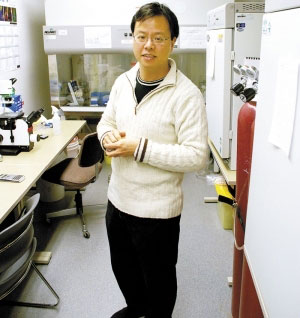| Posted: April 1, 2009 |
Nanotechnology could unlock safer cancer treatments |
|
(Nanowerk News) A team of researchers at the University of Alberta is developing a set of advanced nanotechnology particles that could one day replace radiation and chemotherapy as a cancer treatment.
|
|
The miniscule nanoparticles, about 100 times smaller than the width of a human hair, have the ability to deliver genetic material and medicines to targeted cells.
|
|
Dr Jie Chen, an associate professor of electrical engineering with a focus in biomedical nanotechnology, patented the particles, called M-nanodarts, in November 2008.
|
 |
| Jie Chen
|
|
“I got interested in this research because I think this is the next wave of technology. People live longer, and they want a better quality of life. Because nano is small [...] nano as a medicine for diagnosis and improving treatments is very promising,” Chen said.
|
|
Depending on what type of disease is being targeted, different types of organic matter are bound with the M-nanodots, which are then injected to the specific area and triggered by ultrasound waves.
|
|
“The particle itself is dumb, only sensitive to the ultrasound. So in order to target it to a specific tumor, you need to bind it with bio-molecules,” Chen said.
|
|
“Right now we are working on binding it with a hormone for instance, which could be used to treat breast cancer.”
|
|
Unlike radiation, the ultrasound waves that trigger a reaction in the particles aren’t harmful to surrounding cells.
|
|
“The ultrasound will generate these microbubbles [...] When the bubble bursts, it will get the chemicals to damage the [cancer] cell membrane,” he said.
|
|
The chemical portion of the treatment is the organic matter attached to the technology.
|
|
“There’s a special bamboo that grows in China and Japan. On this bamboo there is a fungi, this fungi is sensitive to ultrasound,” Chen said.
|
|
So far, others in the research community are wary of possible side effects because the particles don’t break down and can disrupt functions in other parts of the body. However, Chen is optimistic that continued tests will demonstrate the strategy to be safe.
|
|
“We didn’t do a systematic study yet for the toxicity. But what we’re thinking about is, this particle is a natural product, it probably will deposit in the body,” Chen explained. “What are the side effects? We’ll need to wait and see. We did the mice study [and] it was okay.”
|
|
If animal trials continue to be successful, testing the treatment on humans could begin as early as this fall. However, due to the lengthy approval process, Chen estimates widespread use taking about six to ten years.
|
|
The application of Chen’s gene delivery particles is not limited to cancer alone. Magnetic forces can be used to pull the M-nanodarts, carrying specific genes, into the nuclei of modified stem cells. They can be grown in a lab for later transplant into a patient.
|
|
Diseases such as hepatitis, Alzheimer’s, Parkinson’s, and cystic fibrosis could possibly all be treated with the tiny particles.
|

